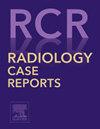An overlooked cause of forefoot pain in athletes: Avascular necrosis of the lateral hallucial sesamoid
Q4 Medicine
引用次数: 0
Abstract
Avascular necrosis (AVN) of the hallucial sesamoids is a rare and often overlooked source of forefoot pain, particularly in athletic populations. We present a case of a 39-year-old female athlete with a 1-year history of progressive pain localized to the plantar aspect of the left first metatarsophalangeal (MTP) joint. The pain had intensified over the previous 6 weeks, especially during weight-bearing activities. Notably, the patient had undergone surgical excision of the right lateral sesamoid 20 years earlier due to a similar diagnosis, which is visible on current postoperative radiographs. Radiographic imaging showed sclerosis and fragmentation of the left lateral sesamoid. MRI confirmed AVN. The patient underwent sesamoidectomy combined with a biplanar Chevron osteotomy to correct moderate hallux valgus and offload the preserved medial sesamoid. Histopathological analysis confirmed the diagnosis. The postoperative recovery was successful, with complete resolution of symptoms. This case emphasizes the necessity of including avascular necrosis in the differential diagnosis of chronic forefoot pain. The case also demonstrates the importance of combining targeted excision and realignment osteotomy in individuals with recurrent or bilateral disease to improve biomechanics and preserve joint function.
运动员前脚疼痛的一个被忽视的原因:外侧幻觉籽骨的缺血性坏死
无血管性坏死(AVN)的幻觉籽状体是一种罕见的,经常被忽视的前足疼痛的来源,特别是在运动人群。我们提出一个39岁的女运动员的情况下,1年的进行性疼痛的历史定位在足底的左第一跖趾(MTP)关节。在过去的6周内,疼痛加剧,特别是在负重活动期间。值得注意的是,由于类似的诊断,患者在20年前接受了右侧外侧籽骨的手术切除,这在目前的术后x线片上是可见的。影像学显示左侧外侧籽骨硬化和碎裂。MRI证实AVN。患者行籽突切除联合双面形截骨术矫正中度拇外翻,并切除保留的内侧籽突。组织病理学分析证实了诊断。术后恢复顺利,症状完全缓解。这个病例强调了在鉴别诊断慢性前足疼痛时必须包括缺血性坏死。该病例还表明,对于复发性或双侧疾病患者,联合靶向切除和复位截骨对于改善生物力学和保持关节功能的重要性。
本文章由计算机程序翻译,如有差异,请以英文原文为准。
求助全文
约1分钟内获得全文
求助全文
来源期刊

Radiology Case Reports
Medicine-Radiology, Nuclear Medicine and Imaging
CiteScore
1.10
自引率
0.00%
发文量
1074
审稿时长
30 days
期刊介绍:
The content of this journal is exclusively case reports that feature diagnostic imaging. Categories in which case reports can be placed include the musculoskeletal system, spine, central nervous system, head and neck, cardiovascular, chest, gastrointestinal, genitourinary, multisystem, pediatric, emergency, women''s imaging, oncologic, normal variants, medical devices, foreign bodies, interventional radiology, nuclear medicine, molecular imaging, ultrasonography, imaging artifacts, forensic, anthropological, and medical-legal. Articles must be well-documented and include a review of the appropriate literature.
 求助内容:
求助内容: 应助结果提醒方式:
应助结果提醒方式:


